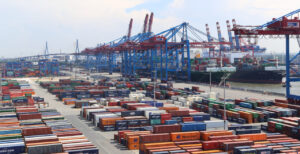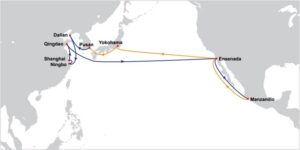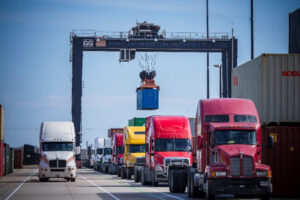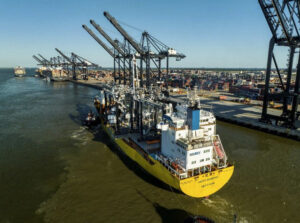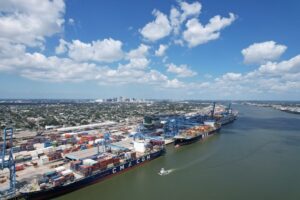Peel Ports has said it is investing in the Port of Liverpool to build a more resilient UK supply chain in the wake of Brexit and the COVID-19 pandemic.
This comes following the arrival of five ZPMC cantilever rail-mounted cranes (CRMG) at its deep-water container terminal, Liverpool2.
Speaking to Port Technology International, the port operator said the effects of the pandemic have not deterred it from pursuing its investment strategy and that it has been able to take advantage of supply chain shifts and support the free flow of goods.
Reacting to a changing supply chain
“Historically UK-trade has had an over reliance on southern ports, which has led to pinch points in the entry of goods into the country,” the port operator said.
“The combined pressures of COVID and Brexit, have led to such ports experiencing long delays and restrictions in the movement of goods as a result.
“The last 12 months have brought some unique challenges for UK supply chains and brought to the forefront the importance of investing in robust, resilient and agile supply chains.
“Following a Brexit deal, the big challenge for those businesses with customers in EU-member states is adapting to the changes which follow, these centre on everything from new paperwork, customs clearance, resourcing and new processes and information flows.”
Anticipating Brexit-caused delays, Peel Ports made significant investments across its ports to ensure it had enough capacity to accommodate cargo switching routes and modes. This included increasing throughput capacities for HGV trailers, containers and storage.
The investments include plans to expand and upgrade the Port of Liverpool’s container handling capabilities, in particular the Liverpool2 terminal.
Peel Ports said Liverpool2 uses leading edge technology across its entire operations, from advanced container handling equipment to the latest vehicle booking systems, automated gates through one integrated operational platform.
“Each step of the operational process is automated with the latest Navis N4 and ABB systems to ensure all the operational streams are secure and efficient.
“This includes the tracking and haulage vehicle from point of entry to the point of departure throughout the terminal.”
Once haulage in transit to their final destination the cranes are issued with work orders to get into position to minimise the time the truck spends in the yard, the port operator continued.
This allows for a seamless cargo transitions and minimal turnaround times for trucks.
The latest ABB technology is installed across all ship-to-shore (STS) cranes giving the driver all the information and enhanced driver automated functionality they need to perform their function to the highest level of performance.
Its latest batch of CRMG cranes are installed with LED lighting to cut emissions and ABB drives and motors, which have been calculated to ensure the operation achieves its performance levels with minimal energy consumption.
“Further gains are made by the intelligence within the control system, synchronising multiple movements on the individual crane as well as cranes grouped together,” Peel Ports explained.
Can Liverpool drive the UK towards growth?
Previous investments mean the Port’s Liverpool2 terminal is capable of handling two 380m vessels simultaneously and its location can eliminate 200 miles of road or rail transport per container journey in the UK.
Peel Ports said the Port can be a driver of economic growth in the North of England and North West, as it offers the quickest and cheapest route to major markets and is the best-connected terminal in the country.
“Over the last few weeks, we have shown that we are well-positioned for global growth,” Peel Ports claimed.
“The Port of Liverpool has always been and will continue to be a key location for UK trade and with these new changes, we are able to showcase the value that we can bring to supply chains in the North.
“As well as helping drive investment into the North West, it also helps alleviate some of the pinch points on supply chains which have previously relied on Southern ports and helped to build supply chain resiliency during this time of change.”


